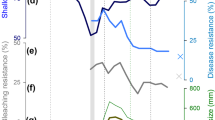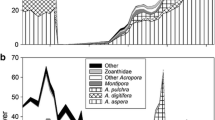Abstract
In an eastern-Pacific coral assemblage at Devil’s Crown, Galápagos Islands, Ecuador, two coral species, Psammocora stellata and Cycloseris (Diaseris) distorta, form dense populations of unattached colonies on sand and rubble substrata. In the Galápagos, living C. (D.) distorta is found only at this single site, whereas populations of P. stellata are found throughout the Archipelago. Six cores dating to ~ 7700 yBP showed P. stellata to be dominant throughout the history of this isolated community, but C. (D.) distorta increased in abundance from ~ 2200 yBP and reached peak abundance between 1471 yBP and the present. The relative frequency of the two coral species may be linked to millennial-scale climatic variability, and this site may represent a refuge for C. (D.) distorta from unfavorable climatic fluctuations on millennial timescales. Our results demonstrate that some corals can persist in isolated populations for millennia.




Similar content being viewed by others
References
Alvarado JJ, Grassian B, Cantera-Kinz JR, Carballo JL, Londono-Cruz E (2017) Coral reef bioerosion in the eastern tropical Pacific. In: Glynn PW, Manzello DP, Enochs IC (eds) Coral Reefs of the Eastern Tropical Pacific. Springer, Dordrecht, pp 369–405
Alvarez-Filip L, Gill JA, Dulvy NK, Perry AL, Watkinson AR, Côté IM (2011) Drivers of region-wide declines in architectural complexity on Caribbean reefs. Coral Reefs 30:1051–1060
Banks S, Vera M, Chiriboga A (2009) Establishing reference points to assess long-term change in zooxanthellate coral communities of the northern Galápagos coral reefs. Galápagos Res 66:43–64
Becker RA, Wilks AR (1993) Maps in S. AT&T Bell Lab Stat Res Rep 93:2
Bongaerts P, Smith TB (2019) Beyond the “deep reef refuge” hypothesis: a conceptual framework to characterize persistence at depth. In Loya Y, Puglise KA, Bridge TCL (eds) Mesophotic coral ecosystems. Coral Reefs of the World Vol. 12, Springer, Dordrecht, 881–895
Bruno JF, Selig ER (2007) Regional decline of coral cover in the Indo-Pacific: timing, extent, and sub-regional comparisons. PLoS ONE 2:e711
Cacciapaglia C, van Woesik R (2015) Reef-coral refugia in a rapidly changing ocean. Global Change Biol 21:2272–2282
Carpenter KE, Abrar M, Aeby G, Aronson RB, Banks S, Bruckner A, Chiriboga A, Cortés J, Delbeek JC, DeVantier L, Edgar GJ, Edwards AJ, Fenner D, Guzmán H, Hoeksema B, Hodgson G, Johan O, Licuanan WY, Livingstone SR, Lovell ER, Moore JA, Obura DO, Ochavillo D, Polidoro BA, Precht WF, Quibilan MC, Reboton C, Richards ZT, Rogers AD, Sanciangco J, Sheppard A, Sheppard C, Smith J, Stuart S, Turak E, Veron JEN, Wallace C, Weil E, Wood E (2008) One third of reef-building corals face elevated extinction risk from climate change and local impacts. Science 321:560–563
Chollett I, Mumby PJ, Cortés J (2010) Upwelling areas do not guarantee refuge for coral reefs in a warming ocean. Mar Ecol Prog Ser 416:47–56
Colley S, Feingold JS, Peña J, Glynn PW (2002) Reproductive ecology of Diaserisdistorta (Michelin) (Fungiidae) in the Galápagos Islands, Ecuador. Proceedings of the 9th International Coral Reef Symposium, Bali, Indonesia 1:373–379
Cortés J (1997) Biology and geology of Eastern Pacific coral reefs. Coral Reefs 16:39–46
Cortés J, Macintyre IG, Glynn PW (1994) Holocene growth history of an eastern Pacific fringing reef, Punta Islotes, Costa Rica. Coral Reefs 13:65–73
Dardeau MR, Aronson RB, Precht WF, Macintyre IG (2000) Use of a hand-operated, open-barrel corer to sample uncemented Holocene coral reefs. Muller P and French L(eds) Diving for Science in the 21st century: 20th Annual Symposium of the American Academy of Underwater Sciences. St. Petersburg, FL, pp 6–9
Feingold JS (1995) Effects of elevated water temperature on coral bleaching and survival during El Niño disturbance events. Ph.D. thesis, University of Miami, Coral Gables, Florida, p 236
Feingold JS (1996) Coral survivors of the 1982–83 El Niño-Southern Oscillation, Galápagos Islands. Ecuador. Coral Reefs 15:108
Feingold JS (2001) Responses of three coral communities to the 1997–98 El Niño-Southern Oscillation: Galápagos Islands, Ecuador. Bull Mar Sci 69:61–77
Feldman GC (1986) Patterns of phytoplankton production around the Galapagos Islands. In Bowman J, Yentsch M and Peterson WT (eds) Tidal Mixing and Plankton Dynamics. Lecture Notes on Coastal and Estuarine Studies Vol. 17, Springer, Berlin 77–106
Gardner TA, Côté IM, Gill JA, Grant A, Watkinson AR (2003) Long-term region-wide declines in Caribbean corals. Science 301:958–960
Glynn PW (1988) El Niño-Southern Oscillation 1982–1983: Nearshore population, community, and ecosystem responses. Ann Rev Ecol Syst 19:309–345
Glynn PW, Colgan MW (1992) Sporatic disturbances in fluctuating coral reef environments: El Niño and coral reef development in the Eastern Pacific. Am Zool 32:707–718
Glynn PW, Cortés J, Guzmán HM, Richmond RH (1988) El Niño (1982–83) associated coral mortality and relationship to sea surface temperature deviations in the tropical Eastern Pacific. Proc 6th Int Coral Reef Symp 3:237–243
Glynn PW, Druffel EM, Dunbar RB (1983) A dead Central American coral reef tract: possible link with the Little Ice Age. J Mar Res 41:605–637
Glynn PW, Manzello DP (2015) Bioerosion and coral reef growth: A dynamic balance. In: Birkeland C (ed) Coral reefs in the Anthropocene. Springer, Dordrecht, pp 67–97
Glynn PW, Maté JL, Baker AC, Calderón MO (2001) Coral bleaching and mortality in Panamá and Ecuador during the 1997–1998 El Niño-Southern Oscillation event: spatial/temporal patterns and comparisons with the 1982–1983 event. Bull Mar Sci 69:79–109
Glynn PW, Feingold JS, Baker A, Banks S, Baums I, Cole J, Colgan MW, Fong P, Glynn PJ, Keith I, Manzello D, Riegl B, Ruttenberg BI, Smith T, Vera-Zambrano M (2018) Status of corals and coral reefs of the Galapagos Islands (Ecuador): Past, present, and future. MarPollut Bull 133:717–733
Glynn PW, Colley SB, Carpizo-Ituarte E, Richmond R (2017a) Coral reproduction in the Eastern Pacific. In: Glynn PW, Manzello DP, Enochs IC (eds) Coral Reefs of the Eastern Tropical Pacific. Springer, Dordrecht, pp 435–476
Glynn PW, Alvarado JJ, Banks S, Cortés J, Feingold JS, Jiménez C, Maragos JE, Martínez P, Maté JL, Moanga DA, Navarrete S, Reyes-Bonilla H, Riegl B, Rivera F, Vargas-Ángel B, Wieters EA, Zapata FA (2017b) Eastern Pacific Coral Reef Provinces, Coral Community Structure and Composition: An Overview. In: Glynn PW, Manzello DP, Enochs IC (eds) Coral Reefs of the Eastern Tropical Pacific. Springer, Dordrecht, pp 107–176
Glynn PW, Wellington GM (1983) Corals and coral reefs of the Galápagos Islands. Univ. California Press, Berkeley
Hoeksema BW (1989) Taxonomy, Phylogeny, and Biogeography of mushroom corals (Scleractinia: Fungiidae). ZoolVerh 254:1–295
Hoeksema BW, Bouwmeester J, Range P, Ben-Hamadou R (2018) A large aggregation of self-fragmenting mushroom corals in the Arabian/Persian Gulf. Ecology 99:1236–1238
Hoeksema BW, Sellanes J, Easton EE (2019) A high-latitude, mesophotic Cycloseris field at 85 m depth off Rapa Nui (Easter Island). Bull Mar Sci 95:101–102
Karnauskas KB, Jenouvrier S, Brown CW, Murtugudde R (2015) Strong sea surface cooling in the eastern equatorial Pacific and implications for Galapagos Penguin conservation. Geophys Res Lett 42:6432–6437
Kuffner IB, Toth LT (2016) A geological perspective on the degradation and conservation of western Atlantic coral reefs. Cons Biol 30:706–715
Kuffner IB, Walters LJ, Becerro MA, Paul VJ, Ritson-Williams R, Beach KS (2006) Inhibition of coral recruitment by macrroalgae and cyanobacteria. Mar Ecol Prog Ser 323:107–117
Macintyre IM, Glynn PW, Cortés J (1992) Holocene reef history in the Eastern Pacific: Mainland Costa Rica, Caño Island, Cocos Island, and Galápagos Islands. Proc 7th Int Coral Reef Symp 2:1174–1184
Maté JL (2003) Corals and coral reefs of the Pacific coast of Panamá. In: Cortés J (ed) Latin American Coral Reefs. Elsevier, Amsterdam, pp 387–417
McBirney AR, Williams H (1969) Geology and Petrology of the Galapagos Islands. CO, Geol Soc Am, Boulder, p 196
Oppo DW, Rosenthal Y, Linsley BK (2009) 2,000-year-long temperature and hydrology reconstructions from the Indo-Pacific warm pool. Nature 460:1113–1116
Pante E, Bouhet BS (2013) marmap: A package for importing, plotting and analyzing bathymetric and topographic data in R. PLoS One 8:e73051
Randall CJ, Toth LT, Leichter JJ, Maté J., Aronson RB (2020) Upwelling buffers climate change impacts on coral reefs of the eastern tropical Pacific. Ecology
Reaka-Kudla ML, Feingold JS, Glynn PW (1996) Experimental studies of rapid bioerosion of coral reefs in the Galápagos Islands. Coral Reefs 15:101–107
Rein B (2007) How do the 1982/83 and 1997/98 El Niños rank in a geological record from Peru? Quat Int 161:56–66
Riegl B, Glynn PW, Banks S, Keith I, Rivera F, Vera-Zambrano M, D’Angelo C, Wiedenmann J (2019a) Heat attenuation and nutrient delivery by localized upwelling avoided coral bleaching mortality in northern Galapagos during 2015/16 ENSO. Coral Reefs 38:773–785
Riegl B, Johnston M, Glynn PW, Keith I, Rivera F, Vera-Zambrano M, Banks S, Feingold J, Glynn PJ (2019b) Some environmental and biological determinants of coral richness, resilience and reef building in Galapagos (Ecuador). Sci Rep 10322, www.nature.com/articles/s41598-019-46607-9
Riegl B, Piller WE (2003) Possible refugia for reefs in times of environmental stress. Int J Earth Sci 92:520–531
Rosenzweig ML, Abramsky Z (1986) Centrifugal community organization. Oikos 46:339–348
Toth LT, Aronson RB (2019) The 4.2 ka event, ENSO, and coral reef development. Clim Past 15:105–119
Toth LT, Aronson RB, Vollmer SV, Hobbs JW, Urrego DH, Cheng H, Enochs IC, Combosch DJ, van Woesik R, Macintyre IG (2012) ENSO drove 2500-year collapse of eastern Pacific coral reefs. Science 337:81–84
Toth LT, Aronson RB, Cheng H, Edwards RL (2015a) Holocene variability in the intensity of wind-gap upwelling in the tropical eastern Pacific. PaleoceanogrPaleoclimatol 30:1113–1131
Toth LT, Aronson RB, Cobb KM, Cheng H, Edwards RL, Grothe PR, Sayani HR (2015b) Climatic and biotic thresholds of coral-reef shutdown. Nature Clim Change 5:369–374
Toth LT, Macintyre IG, Aronson RB (2017) Holocene reef development in the eastern tropical Pacific. In: Glynn PW, Manzello DP, Enochs IC (eds) Coral Reefs in the Eastern Tropical Pacific. Springer, Dordrecht, pp 177–203
Toth LT, Kuffner IB, Stathakopoulos A, Shinn EA (2018) A 3000-year lag between the geological and ecological shutdown of Florida’s coral reefs. Global Change Biology 24:5471–5483. https://doi.org/10.1111/gcb.14389
Witman JD, Brandt M, Smith F (2010) Coupling between subtidal prey and consumers along a mesoscale upwelling gradient in the Galapagos Islands. EcolMonogr 80:153–177
Wood S, BaumsIB ParisCB, RidgwellA Kessler WS, HendyE J (2016) El Niño and coral larval dispersal across the eastern Pacific marine barrier. Nat Comm 7:12571
Acknowledgements
We are grateful to The Galápagos National Park Directorate (GNPD) and Charles Darwin Research Station for their support of this research. We thank Godfrey Merlen, René Espinosa and Michael Moore for assistance with core collection. Fernando Rivera also helped with collecting cores, freely shared his vast knowledge of Ecuadorian corals and helped with many field trips. William F. Precht gave useful advice on the manuscript. Galápagos field research was supported by National Science Foundation (NSF) grant OCE-9018392 to PWG, and OCE-9218197 and a Grant-in-Aid of Research from Sigma Xi to JSF. KH was supported by a Presidential Tuition Fellowship at Nova Southeastern University. RBA and LTT were supported by grant OCE-1535007 from the NSF. LTT was also supported by the Coastal/Marine Hazards and Resources Program of the US Geological Survey. Any use of trade, firm or product names is for descriptive purposes only and does not imply endorsement by the US Government. This is contribution no. 226 from the Institute for Global Ecology at the Florida Institute of Technology.
Author information
Authors and Affiliations
Corresponding author
Ethics declarations
Conflict of interest
On behalf of all authors, the corresponding author states that there is no conflict of interest.
Additional information
Topic Editor Mark R. Patterson
Publisher's Note
Springer Nature remains neutral with regard to jurisdictional claims in published maps and institutional affiliations.
Electronic supplementary material
Below is the link to the electronic supplementary material.
Rights and permissions
About this article
Cite this article
Feingold, J.S., Riegl, B., Hendrickson, K. et al. 7700-year persistence of an isolated, free-living coral assemblage in the Galápagos Islands: a model for coral refugia?. Coral Reefs 39, 639–647 (2020). https://doi.org/10.1007/s00338-020-01935-5
Received:
Accepted:
Published:
Issue Date:
DOI: https://doi.org/10.1007/s00338-020-01935-5




